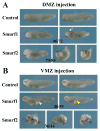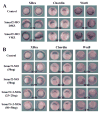Regulation of early xenopus embryogenesis by Smad ubiquitination regulatory factor 2
- PMID: 22674516
- PMCID: PMC3399951
- DOI: 10.1002/dvdy.23811
Regulation of early xenopus embryogenesis by Smad ubiquitination regulatory factor 2
Abstract
Background: Smad ubiquitination regulatory factor (Smurf) 1 and 2 are E3 ubiquitin ligases originally identified as inhibitors of transforming growth factor beta signaling and are shown to modulate multiple cellular activities. The roles of Smurfs in vertebrate embryogenesis, however, are not completely understood.
Results: Here we investigate the function of Smurf2 during early Xenopus development. We show that distinctly from Smurf1, overexpression of Smurf2 in presumptive mesoderm interfered with mesoderm induction and caused axial defects, whereas knockdown of Smurf2 with antisense morpholino oligonucleotides resulted in expansion of the mesoderm. These results imply that Smurf2 may modulate nodal-mediated mesodermal induction. Consistently, ventral expression of Smurf2 induced a partial secondary axis with head structures. In the ectoderm, Smurf2 resembled Smurf1 in controlling neural and epidermal marker expression and influencing head formation. Smurf1, but not Smurf2, additionally affected neural tube closure. Interestingly, both Smurfs could enhance as well as repress neural crest markers, implying that they modulate their targets dynamically during neural plate border specification.
Conclusion: Our data demonstrate that Smurf1 and Smurf2 have overlapping and distinct functionalities during early frog embryogenesis; collectively, they regulate ectodermal and mesodermal induction and patterning to ensure normal development of Xenopus embryos.
Copyright © 2012 Wiley Periodicals, Inc.
Figures










Similar articles
-
The Smurf ubiquitin ligases regulate tissue separation via antagonistic interactions with ephrinB1.Genes Dev. 2013 Mar 1;27(5):491-503. doi: 10.1101/gad.208355.112. Genes Dev. 2013. PMID: 23475958 Free PMC article.
-
Smurf2 induces ubiquitin-dependent degradation of Smurf1 to prevent migration of breast cancer cells.J Biol Chem. 2008 Dec 19;283(51):35660-7. doi: 10.1074/jbc.M710496200. Epub 2008 Oct 16. J Biol Chem. 2008. PMID: 18927080
-
Tumor necrosis factor-receptor-associated factor-4 is a positive regulator of transforming growth factor-beta signaling that affects neural crest formation.Mol Biol Cell. 2009 Jul;20(14):3436-50. doi: 10.1091/mbc.e08-03-0325. Epub 2009 May 20. Mol Biol Cell. 2009. PMID: 19458200 Free PMC article.
-
The functions and regulation of Smurfs in cancers.Semin Cancer Biol. 2020 Dec;67(Pt 2):102-116. doi: 10.1016/j.semcancer.2019.12.023. Epub 2019 Dec 30. Semin Cancer Biol. 2020. PMID: 31899247 Review.
-
The role of SMURFs in non-cancerous diseases.FASEB J. 2023 Aug;37(8):e23110. doi: 10.1096/fj.202300598R. FASEB J. 2023. PMID: 37490283 Review.
Cited by
-
Bone morphogenetic proteins and inner ear development.J Zhejiang Univ Sci B. 2019 Feb.;20(2):131-145. doi: 10.1631/jzus.B1800084. Epub 2018 Aug 4. J Zhejiang Univ Sci B. 2019. PMID: 30112880 Free PMC article. Review.
-
The E3 ubiquitin ligase SMURF1 regulates cell-fate specification and outflow tract septation during mammalian heart development.Sci Rep. 2018 Jun 22;8(1):9542. doi: 10.1038/s41598-018-27854-8. Sci Rep. 2018. PMID: 29934521 Free PMC article.
-
MicroRNA Profiling of Neurons Generated Using Induced Pluripotent Stem Cells Derived from Patients with Schizophrenia and Schizoaffective Disorder, and 22q11.2 Del.PLoS One. 2015 Jul 14;10(7):e0132387. doi: 10.1371/journal.pone.0132387. eCollection 2015. PLoS One. 2015. PMID: 26173148 Free PMC article.
-
The Smurf ubiquitin ligases regulate tissue separation via antagonistic interactions with ephrinB1.Genes Dev. 2013 Mar 1;27(5):491-503. doi: 10.1101/gad.208355.112. Genes Dev. 2013. PMID: 23475958 Free PMC article.
References
-
- Amaravadi LS, Neff AW, Sleeman JP, Smith RC. Autonomous neural axis formation by ectopic expression of the protooncogene c-ski. Dev Biol. 1997;192:392–404. - PubMed
-
- Aybar MJ, Mayor R. Early induction of neural crest cells: lessons learned from frog, fish and chick. Curr Opin Genet Dev. 2002;12:452–458. - PubMed
-
- Baker CV, Bronner-Fraser M. The origins of the neural crest. Part I: embryonic induction. Mech Dev. 1997;69:3–11. - PubMed
-
- Barembaum M, Bronner-Fraser M. Early steps in neural crest specification. Semin Cell Dev Biol. 2005;16:642–646. - PubMed
Publication types
MeSH terms
Substances
Grants and funding
LinkOut - more resources
Full Text Sources

